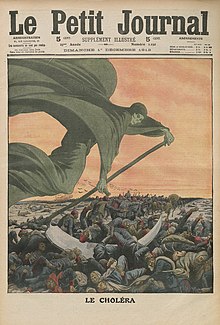The primary symptoms of cholera are profuse, painless diarrhea and vomiting of clear fluid.[1] These symptoms usually start suddenly, one to five days after ingestion of the bacteria.[1] The diarrhea is frequently described as "rice water" in nature and may have a fishy odor.[1] An untreated person with cholera may produce 10–20 litres of diarrhea a day[1] with fatal results. For every symptomatic person, 3 to 100 people get the infection but remain asymptomatic.[2] Cholera has been nicknamed the "blue death" due to a patient's skin turning a bluish-gray hue from extreme loss of fluids.[3]
If the severe diarrheoea is not treated with intravenous rehydration, it can result in life-threatening dehydration and electrolyte imbalances.[1] The typical symptoms of dehydration include low blood pressure, poor skin turgor (wrinkled hands), sunken eyes, and a rapid pulse.[1]
Cause
Transmission is primarily by the fecal contamination of food and water caused by poor sanitation.[4] This bacterium can, however, live naturally in any environment.[5]
Susceptibility
About 100 million bacteria must typically be ingested to cause cholera in a normal healthy adult.[1] This dose, however, is less in those with lowered gastric acidity (for instance those using proton pump inhibitors).[1] Children are also more susceptible, with two- to four-year-olds having the highest rates of infection.[1] Individuals' susceptibility to cholera is also affected by their blood type, with those with type O blood being the most susceptible.[1][6] Persons with lowered immunity, such as persons with AIDS or children who are malnourished, are more likely to experience a severe case if they become infected.[7] However, it should be noted that any individual, even a healthy adult in middle age, can experience a severe case, and each person's case should be measured by the loss of fluids, preferably in consultation with a doctor or other health worker.
The cystic fibrosis genetic mutation in humans has been said to maintain a selective advantage: heterozygous carriers of the mutation (who are thus not affected by cystic fibrosis) are more resistant to V. cholerae infections.[8] In this model, the genetic deficiency in the cystic fibrosis transmembrane conductance regulator channel proteins interferes with bacteria binding to the gastrointestinal epithelium, thus reducing the effects of an infection.
Transmission
Cholera is typically transmitted by either contaminated food or water. In the developed world, seafood is the usual cause, while in the developing world it is more often water.[1] Cholera has been found in only two other animal populations: shellfish and plankton.[1]
People infected with cholera often have diarrhea, and if this highly liquid stool, colloquially referred to as "rice-water" or "faucet butt", contaminates water used by others, disease transmission may occur.[9] The source of the contamination is typically other cholera sufferers when their untreated diarrheal discharge is allowed to get into waterways, groundwater or drinking water supplies. Drinking any infected water and eating any foods washed in the water, as well as shellfish living in the affected waterway, can cause a person to contract an infection. Cholera is rarely spread directly from person to person. Both toxic and nontoxic strains exist. Nontoxic strains can acquire toxicity through a temperate bacteriophage.[10] Coastal cholera outbreaks typically follow zooplankton blooms, thus making cholera a zoonotic disease.

